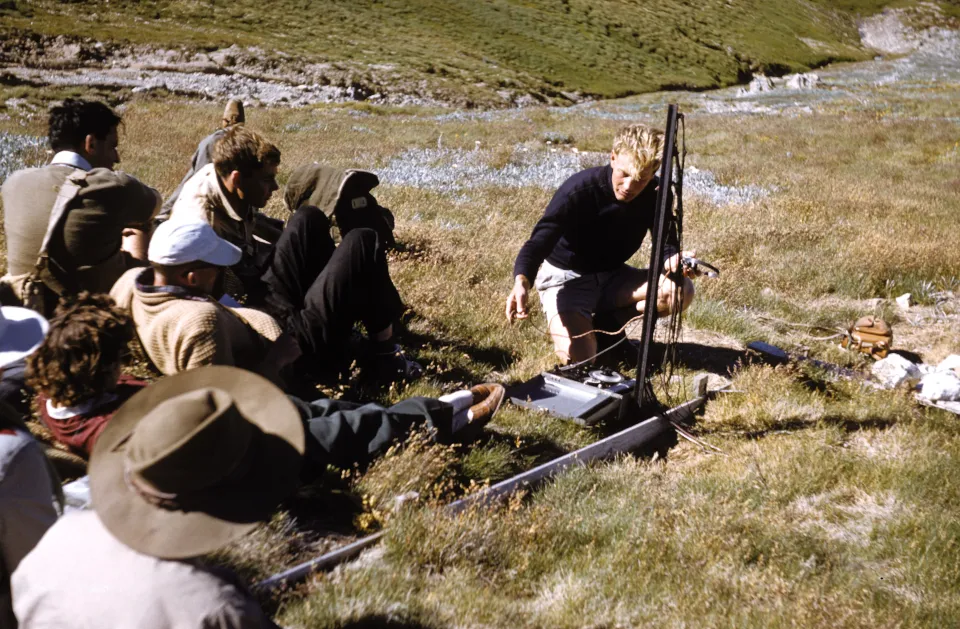Vale Dr Alec Costin AM 30/09/1925 – 22/08/2022

The Australian alpine scientific community is saddened by the loss of Dr Alec Costin, who passed away peacefully at home on 22nd August 2022.
Ken and Mary Green visited Alec regularly over the last few months, and they remember his beam of smile when they arrived and ‘Alec just being Alec’. With his ever-sharp mind he never stopped reading nor asking questions about the current science and the issues concerning Kosciuszko National Park and the other alpine regions of Australia.
Alec’s career focussed on understanding and conserving the alpine and high-elevation regions of the continent with a particular focus on the Monaro and Kosciuszko regions. In 1980 he was made a Fellow of the Australian Academy of Science and in 1986 given a member of the order of Australia for Service to Conservation, presented by the Queen.
Alec was one of the first members of the Australian Institute of Alpine Studies when it formed in 1998.
An excerpt from Archiving the Scientific Legacy of Dr. Alec Costin by Genevieve Wright, Keith McDougall and Gavan McCarthy briefly describes Alec’s early scientific career:
Alec Costin was regarded as the father of alpine ecology in Australia. A widely-respected scientist, conservationist and exceptional scientific communicator, Alec was a prolific writer and published many scientific papers. Alec was a mentor and inspiration for many ecologists today and his records are an invaluable resource for future conservation of the Alps.
Alec started his career in alpine ecology in 1946 with the Soil Conservation Service of NSW. He then, through research scholarships, studied mountain environments in other parts of the world. When he returned to Australia, Alec had a short working period in the Victorian Alps before taking up a position in 1955 with CSIRO based in NSW. In this role, Alec continued to focus his research on all aspects of alpine ecology.
Alec’s research on soils, hydrology and vegetation were ground-breaking and were critical for the protection and conservation of the Australian Alps. He successfully lobbied politicians, government departments and research institutions to protect the Alps and without his efforts the Alps would not be conserved as they are today.
Alec published widely but his first major work in 1954, The Ecosystems of the Monaro (Costin, 1954), was one of the first regional studies describing the area’s ecology, ecosystems and management. The study covered over 1.5 million hectares and is a keystone publication still in use today. Alec was also co-author of ‘A report on the Condition of the High Mountain Catchments of New South Wales and Victoria’, which was published by the Australian Academy of Science in 1957. This report identified the massive scale of the soil erosion problem and its impact on catchment stability. It highlighted the incompatibility of burning and grazing practices with high altitude environments and Alec successfully argued that Alps catchments were more valuable for water catchment than for grazing. This document, along with Alec’s activism and lobbying, was a turning point for the conservation of the Australian Alps.
In the years that followed removal of grazing, Alec established research into many critical issues with Dane Wimbush. Together, Alec and Dane investigated the impacts of grazing which established that sheep and cattle were selectively grazing forbs, reducing the diversity of flora and impacting soil stability. This work also found that once the forbs and grass inflorescences were consumed, animals quickly lost weight on a diet of mainly mature snowgrasses (Wimbush and Costin, 1979a).
Alec and Dane established transects in alpine and sub-alpine areas to measure recovery after the grazing had stopped. The transects were measured annually for twenty years and have been maintained ever since (Wimbush and Costin, 1979b and c). They are an incredibly valuable resource for tracking long- term vegetation trends.
Alec’s field notes and data sheets are historically important, as is his large number of Kodachrome slides which are a record of the Alps in the 1950s and 1960s. These slides provide an important resource which may be used to interpret change in vegetation and landscapes in the Australian Alps.
The full article: Archiving the Scientific Legacy of Dr. Alec Costin
https://openjournals.library.sydney.edu.au/index.php/LIN/article/view/12965
Landline video with Alec Costin, Dane Wimbush and Roger Good
https://www.abc.net.au/local/archives/landline/content/2015/s4184837.htm
Australian Academy of Science
A study of the ecosystems of the Monaro region of New South Wales : with special reference to soil erosion
https://catalogue.nla.gov.au/Record/3260483
Conservation, edited by A. B. Costin and H. J. Frith. Penguin
https://catalogue.nla.gov.au/Record/642901
Book review of Conservation:
